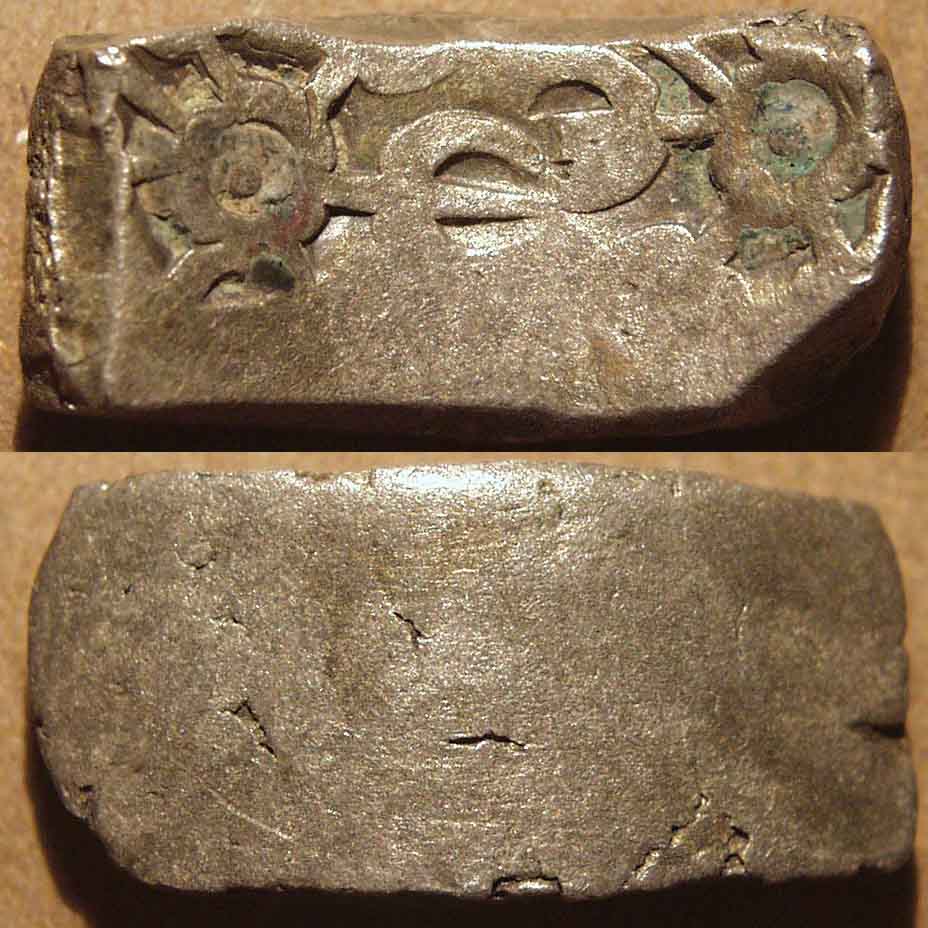
|
|
The Gandhara janapada was located in north-western India, in an area stretching from Kabul in Afghanistan, through much of Pakistani and Indian Punjab. Its capital was the great city of Taxila, renowned for its size and its great university. Gandhara was listed as one of the sixteen mahajanapadas in the Buddhist text Anguttara Nikaya.
At some point in the sixth century BCE, Gandhara was conquered by the Persian emperor Darius, who refers to it as one of his satrapies in an inscription dated to c. 520 BCE. It was the richest of the twenty satrapies in Darius's empire. The Achaemenid kings ruled Gandhara up until the time of Alexander.
The coins here are often attributed to the Achaemenids. Even if they were Achaemenid issues, it is highly probable, however, that the basic design of these coins dates back to the time of the independent Gandharan janapada. The reason is that they are completely unlike any coins that circulated in Persia, such as the running king type, obviously inspired by Greek coins. Indeed, the Gandharan coins form the strongest proof that coinage originated in India prior to the spread of Greek influence. For coins so radically different from the Greek-inspired Persian coinage to circulate in a satrapy of the Persian empire, it must have been the case that they already had a long history of commercial use in the area. The Persians must have discovered, as did the Greeks after them, that Indian merchants did not take easily to new styles of coinage; they liked to stick with tried and true designs with which they were familiar.
|

| Long silver "bent-bar" shatamana
c. 600-300 BCE
Weight:10.88 gm., 8 x 43 mm.
2 six-petalled flowers ? at each end,
smaller punches in between / blank
Ref: Rajgor, 540-541. |

| Long silver "bent-bar" shatamana
c. 600-300 BCE
Weight:11.20 gm., 9 x 42 mm.
2 six-petalled flowers ? at each end,
smaller punch (Taxila) in between / blank
Ref: Rajgor, 540-541. |

| Medium silver "bent-bar" shatamana
c. 600-300 BCE
Weight:11.53 gm., 13 x 27 mm.
2 six-petalled flowers ? at each end / blank
Ref: Rajgor, 546. |

| Medium base silver "bent-bar" shatamana
c. 600-300 BCE
Weight:11.90 gm., 12 x 28 mm.
2 six-petalled flowers ? at each end / blank
Ref: Rajgor, 547. |

| Silver 1/4 shatamana
c. 600-300 BCE
Weight:2.77 gm., 13 x 14 mm.
Six-petalled flower ? / blank
Ref: Rajgor, 561-63. |

| Silver 1/8 shatamana
c. 600-300 BCE
Weight:1.31 gm., 12 x 14 mm.
Six-petalled flower ? with dot / blank
Ref: Rajgor, 569. |

| Silver 1/8 shatamana
c. 600-300 BCE
Weight:1.41 gm., 13 x 16 mm.
Six-petalled flower ? with countermark ? / 2 banker's marks
Ref: Rajgor, 572. |
|
Note that this coin appears to be countermarked on the obverse (at around 10 and 11 o'clock of the image), besides having two banker's marks on the reverse. |

| Base silver 1/16 shatamana
c. 600-300 BCE
Weight:0.43 gm., 9 x 11 mm.
Six-petalled flower ? with dot / blank
Ref: Rajgor, 579. |
|
|